|
Play this game
ChessStart position and game objectChess is played on a standard 64 square chess board. Each player starts to play with 16 pieces - one king, one queen, two rooks, two bishops, two knights and eight pawns. In the start position, all pieces of each player are located in two rows on the player's side, see the following picture.  The object of this game is to checkmate the opponent's king. It means that the player must attack the opponent's king and the king cannot move to a square which is not being attacked by the player's pieces. All kinds of game ends will be described in the next sections. Movement of pieces Many people think that it is pretty difficult to learn how to play chess because "each piece moves in a different way". Although each piece really follows its own move pattern, it is not a problem to learn quickly all basic movements on a chess board. The following pictures show all pieces and their move abilities (shown by green crosses). King  A king can move only one space in any direction. The only exception is castling when a king and a rook of the same color make a move together. It is performed by moving a king two spaces horizontally to the left or right and a rook jumps over the king in the opposite direction. The rules distinguish between short and long castling shown by these pictures (the position before and after the castling). Short castling   Long castling 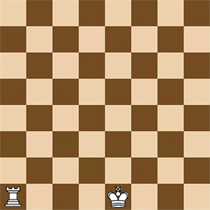 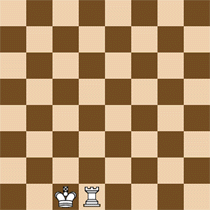 In order to make a castling, these conditions must be fulfilled:
If the player cannot cancel the check, loses the game. The situation is called checkmate. Queen 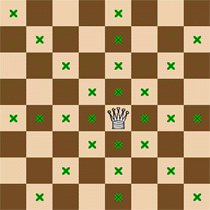 A queen is the most powerful piece on the chess board because it can move any spaces in any direction. Rook 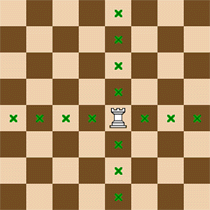 A rook can move any spaces vertically or horizontally and it is the second most powerful piece just after a queen. Bishop 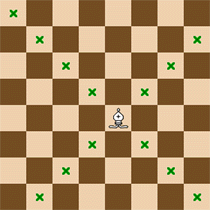 A bishop can move any spaces diagonally. It means that a bishop never stands on a square of an opposite color to its starting square. Each player has two bishops - one is on white squares and the other is on black squares. Knight  Knight's moves are L-shaped - it moves one space vertically or horizontally and then one space diagonally. A knight can jump over other pieces standing in its move line. Pawn Pawns, although they are the weakest pieces on the chess board, are powered by several interesting features and they often determine the game result:
How to capture opponent's pieces If it is the player's turn and one (or more) of his/her pieces can move to a square occupied by an opponent's piece, the player can capture this piece. The capturing means that the player removes the opponent's piece from the board and moves his/her own piece (that made this move) to its place. The captured piece will appear under (or over, depending on the board orientation) the board in Captured pieces field to inform the players about the game status.  The player cannot capture an opponent's piece if other pieces stand in the move line of his/her piece (between the player's piece and the opponent's one). The only exception is a knight who can "jump" over all pieces.  Both players can capture all opponent's pieces except the kings. How to finish the game The game is finished if one of the following conditions is fulfilled:
Other important rules
Play this game See also: Chess, Chinese Chess, Japanese Chess, Corner Chess, Fortress Chess, Horde Chess, Loop Chess, Anti Chess, Extinction Chess, Maharajah Chess, Three Checks Chess, Dark Chess, Atomic Chess, Janus Chess, Embassy Chess, Screen Chess, Crazy Screen Chess, Cylinder Chess, Amazon Chess, Berolina Chess, Fischer Random Chess, Legan Chess, Knight Relay Chess, Grand Chess, Capablanca Random Chess, Los Alamos Chess, Ambiguous Chess, Minishogi, Dice Chess, Recycle Chess, Ice Age Chess, Behemoth Chess, Cheshire Cat Chess, Knightmate Chess, Racing Kings, Dice Chess 10x10, Massacre Chess |
Date and time
Friends online
Favourite boards
Fellowships
Tip of the day
|
|
||||||||||||||||||||||||||||||||||||||||||||||||||||||||||||||||||||||||||
Copyright © 2002 - 2025 Filip Rachunek, all rights reserved. Back to the top |




























